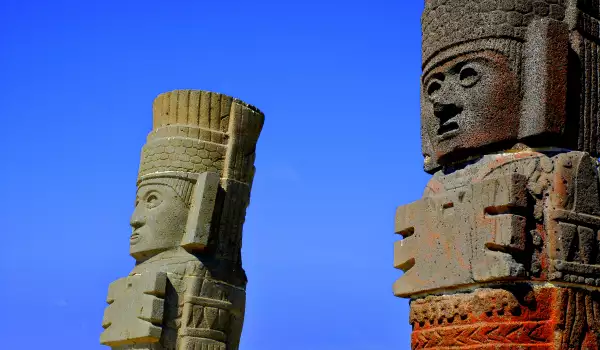Tula, Hidalgo

Tula is the name of the ancient capital of the Toltec. Tula is located about 65 km northwest of Mexico City, and the remains of Tula, who formerly was called Tollan, are dominated by its hill above the modern Mexican town Tula de Allende.
In Tula, today can be seen artefacts from the old ancient civilization of the Toltec, some of which are preserved in very good condition. According to legend, Tula was founded by the mythic figure Quetzalcoatl (the plumed serpent), which was an ancient deity.
The ancient Toltec inherited it from earlier cultures and respected him as a god of Venus. Tula flourished between 750-1168 years. It is assumed that the townspeople have abandoned Tula and settled at the site of the former Mayan city of Chichen Itza in the Yucatan Peninsula. There are buildings there, that are completely in the style of Tula.
It is believed that during its greatest prosperity Tula was covering an area of about 5 square miles and was surrounded by thick and high walls. It is assumed also that Tula was destroyed sometime between 1168 and 1179. The capital of the Toltec was declared a city with such status of second after Teotihuacan, although Tula and failed to catch up with its size.
The ancient city of Tula was founded in 1940 by archaeologist Jorge Acosta, who began excavations in Cerro del Tesoro near Tula de Allende. The very name of the Toltecs can be translated as "reed people" who come from their city Tula, meaning "land of reeds."
Excavations in the capital of the Toltec revealed an authentic part of the city with streets, buildings, paths, terraces and tombs, etc. Among the ruins can be seen the remains of a palace, two stadiums and three temples that form of a truncated pyramid. Impressive is the largest temple of the pyramid, which is surmounted by 4, 6-foot columns. They depict stylized human figures, which are believed to be dedicated to the founder Quetzalcoatl.
High statues called Los Atlantes are laid on top of this pyramid, which is now perfectly restored. The pyramid at Tula was small, but at the expense of this, the complex is beautifully decorated. Everywhere there were pictures and figures of animals - mostly large cats and birds of prey devouring human hearts and human faces that come from the jaws of snakes.
In the south can be seen a staircase which leads to a highly ornamented two-room temple. The walls of this part of the Tula pyramid are covered in tuff, which is a type of limestone rock. Everywhere you can see reliefs of jaguars and coyotes, eagles and vultures devouring human hearts. Here is a climax of a strange animal, a mixture between a jaguar, snake and eagle creature that is believed to be Quetzalcoatl.
Again according to the myths Quetzalcoatl was the priest-king of the city of Tula, the Toltec never offered human sacrifices, but sacrifices of snakes, birds and butterflies. Under his administration the city flourished. Toltecs survived by farming, the town had an irrigation system. The end of this nation comes somewhere in the 12th century when the town was looted by other tribes and destroyed by the Aztecs.






